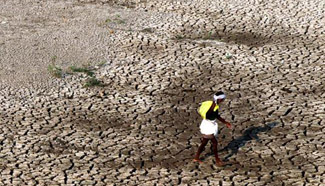SAN FRANCISCO, March 6 (Xinhua) -- Based on 33 years of remote sensing data, researchers at two U.S. universities have found that grasslands in the country are more than three times more sensitive to vapor pressure deficit (VPD), or atmospheric dryness, than they are to precipitation.
The large-scale methods of the study, published Monday online in the journal Nature Geoscience, by researchers at Stanford University and Columbia University to understand plant behavior could be used to improve predictive models of how environments will respond to droughts, which are expected to intensify in the 21st century.
With decades of climate and vegetation satellite data to determine how plants regulate water and carbon dioxide (CO2) under dry conditions, the researchers analyzed the conditions under which grasslands open and close their stomata, microscopic openings on plant leaves that enable the transfer of water vapor, oxygen and CO2. When its stomata are open, a plant can take up CO2 from the atmosphere to make energy but risks losing water in dry conditions.
Whether to risk drying out in order to keep taking up carbon, or to close up and stop growing, the strategy different plants use affects their productivity. And a plant's behavior depends on the amount of water in the atmosphere as measured by VPD: higher VPD indicates greater potential for dry air to pull moisture out of the plant.
"Just looking at changes in precipitation isn't going to tell you the whole story," said lead author Alexandra Konings, an assistant professor of Earth System Science in Stanford's School of Earth, Energy & Environmental Sciences.
"U.S. grasslands are way more sensitive to vapor pressure deficit, which is important. Because VPD is so tightly linked to temperature, we can predict that it's going to keep going up in the future," Konings said.
As the largest land cover type on Earth, accounting for about 26 percent of the United States and nearly 20 percent of the planet's land surface, grasslands are a predominant source of carbon uptake, or storage of carbon from the atmosphere. They host a variety of biodiversity and provide an important habitat for livestock in the meat and dairy industries.
"Carbon uptake is associated with growth and how that responds under climate is a large source of uncertainty in future climate change predictions," Konings said. "Under increasing temperatures, we're going to potentially see a lot less green grasslands - but this study shows that's going to me more true for some regions than others."
Using publicly available remote sensing satellite data from 1981 to 2013 displaying plant greenness, which is an indicator for plant productivity, and then combining that data with climate and observational precipitation datasets to divide American grasslands into different regions, depending on their behavior, the researchers separated out the effect of the plants' behavior from the impacts of regional conditions, such as differences in precipitation or temperature. Although many climate models treat all grasslands the same, the study revealed large variability in terms of how they respond to drought.
Analysis shows grasslands that respond to drought by keeping their stomata open (anisohydric behavior) are more sensitive to dryness of the atmosphere than those that close their stomata and stop growth to save water (isohydric behavior). Both behaviors are present in the United States.
The study shows plants that keep their stomata open are more damaged by drought in U.S. grasslands because it suppresses the plants' growth over the course of a growing season.
"Grasslands are really interesting because they show such a huge diversity in that isohydricity behavior," said Konings, who conducted initial research for the study while a postdoctoral researcher at Columbia before joining Stanford Earth. "They have really different strategies in how they respond to drought."
"More than the plant type, it is the plant physiology that will regulate their response to drought and heat wave," study co-author Pierre Gentine, an associate professor of Earth and Environmental Engineering at Columbia University, was quoted as saying in a news release from Stanford, a private institute of higher learning in Northern California on the U.S. West Coast.












